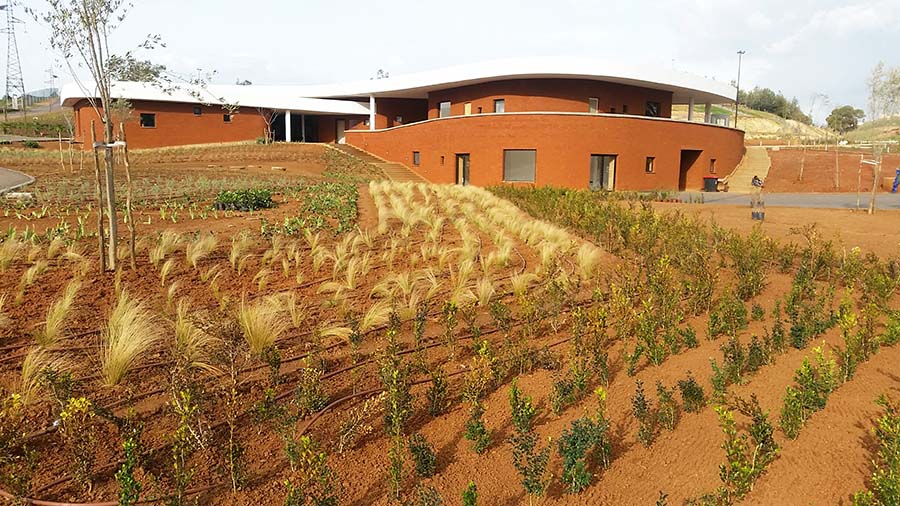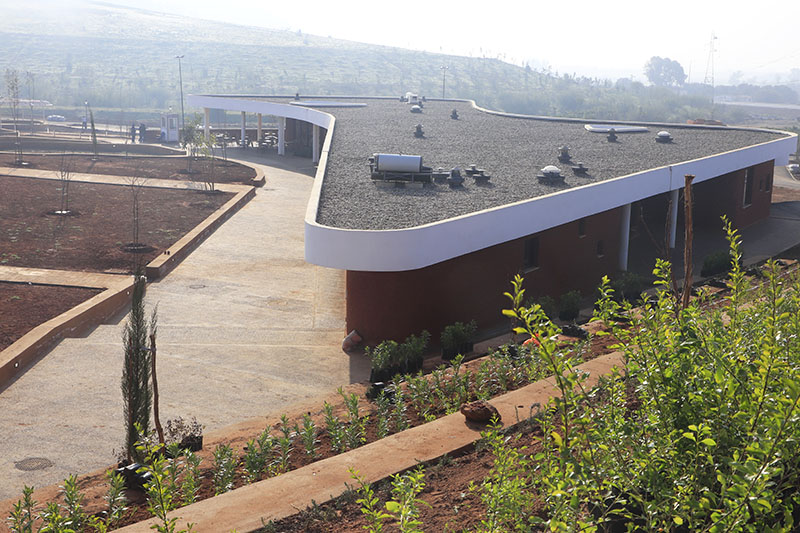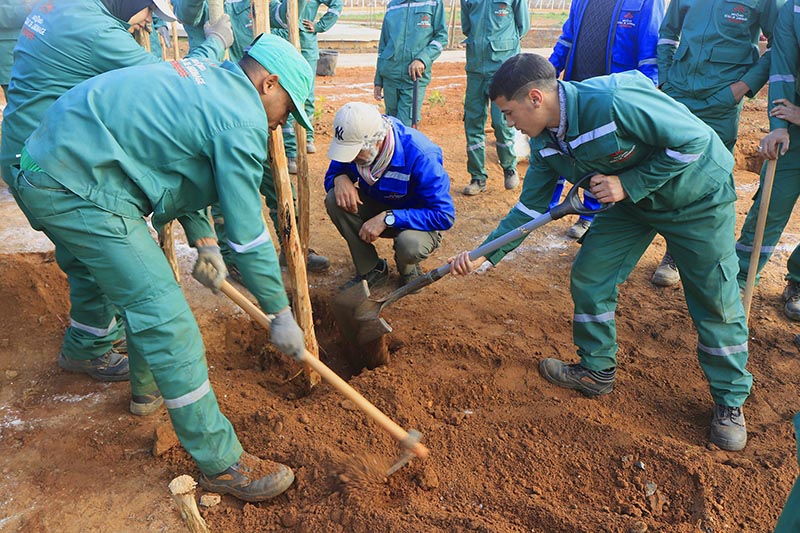Articles, Communications
Flowering news from the School of Gardening of Morocco
Article theme: Cooperation, Garden, Medomed, Sustainability.
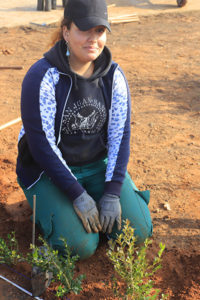 We are already in 2020 and it is time to review our progress. Since the beginning of the new course, in early October, things are quickly moving forward in the School of Gardening of Sale (Morocco). The inconveniences raised by last year’s outside practices with the students have been solved, and this year’s practical work is being carried in the School’s 8-hectares garden and nursery.
We are already in 2020 and it is time to review our progress. Since the beginning of the new course, in early October, things are quickly moving forward in the School of Gardening of Sale (Morocco). The inconveniences raised by last year’s outside practices with the students have been solved, and this year’s practical work is being carried in the School’s 8-hectares garden and nursery.
Spring is promptly arriving to this Atlantic region, and the results can already be noticed. Flowers in bloom, green grasslands, and deciduous trees with bright green buds.
Planting is pleasant, as the first and second grade students point our (these levels correspond to the degrees of professional training and specialization). Spring is promptly arriving to this Atlantic region, and the results can already be noticed. Flowers in bloom, green grasslands, and deciduous trees presenting bright green buds.
 The landscape design that surrounds the school and extends towards the terraced hill and the end of the garden (where the photovoltaic plant is located) is beginning to take shape and to show the results of this wonderful project, result of the collaboration of Mikel García de Eulate, and Gaizka Zuazo and Lorena Torres, from Soilestudio.
The landscape design that surrounds the school and extends towards the terraced hill and the end of the garden (where the photovoltaic plant is located) is beginning to take shape and to show the results of this wonderful project, result of the collaboration of Mikel García de Eulate, and Gaizka Zuazo and Lorena Torres, from Soilestudio.
A formal design that combines its curves and colors, with the red-colored earth, and the beauty of the School’s building, designed by MYAA.
Lilies (Iris germanica), sea lavenders (Limonium perezii), small pomegranates (Punica granatum nana), and wallflowers go hand in hand with olive trees, orange trees, cypresses, carob, Judas trees (Cercis siliquastrum), buxuses (Buxus sempervirens), myrtle (Mirtus comunis), Viburnum tinus, European fan palms, and it will count soon with the Magical North African presence of palm trees (in this case, Phoenix reticulata). To these trees and plants, which currently reach the 120 species, we will soon add some rare indigenous Moroccan species to the nursery. All this takes place in a strict ecological frame. It is a big challenge.
But the most important part of this is the wonderful work carried out prior to the plantation. The students had to flatten, sift and clean the ground, and compost and trace the land according to the landscape plans, which they had to learn to read. It wasn’t an easy task, but with lime, ropes and ruler in hand, the youths soon got hold of the project.
At the end of 2019 we received Alberto Juan y Seva, from the University of Seville and advisor on the project, who reassured us and reaffirmed us in the work carried out.
The students had to flatten, sift and clean the ground, and compost and trace the land according to the landscape plans, which they had to learn to read.
Visits and activities
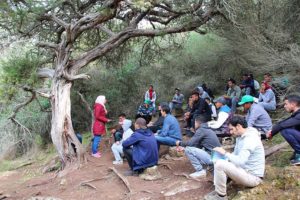 Along with the practical work and the theoretical lessons taught by our Spanish and Moroccan trainers, the students have also carried out a diverse array of activities. We have had the luck of visiting the Maamora Forest, the world’s largest cork oak forest, but also one of the most deteriorated, as well as the Sidi Boughaba lake, which is part of the Ramsar Convention and has great environmental value. Sidi Boughaba, a freshwater lake and surrounded by an impressive Mediterranean vegetation, is a transient and nesting area for important and threatened bird species, such as the red-knobbed coot, the marbled duck, or the Eleanora’s falcon.
Along with the practical work and the theoretical lessons taught by our Spanish and Moroccan trainers, the students have also carried out a diverse array of activities. We have had the luck of visiting the Maamora Forest, the world’s largest cork oak forest, but also one of the most deteriorated, as well as the Sidi Boughaba lake, which is part of the Ramsar Convention and has great environmental value. Sidi Boughaba, a freshwater lake and surrounded by an impressive Mediterranean vegetation, is a transient and nesting area for important and threatened bird species, such as the red-knobbed coot, the marbled duck, or the Eleanora’s falcon.
We have also visited the Nouzha Hassan park, where we updated its botanical signposts, and the Jardin d’Essais Botanqiues of Rabat, where the freshmen year students learnt about the gardens of Al-Andalus, though a visit organized by FUNCI to its Andalusi garden and its small museum on water.
Along with the practical work and the theoretical lessons taught by our Spanish and Moroccan trainers, the students have also carried out a diverse array of activities.
In addition to the lectures on the Islamic civilization and landscape, this year we are trying to promote, not only gardening knowledge, but also personal skills. For instance, we are launching a theatre play directed by one of our students, we are organizing a photo contest, and we are preparing for the next Race for Peace, that will take place next April 5th. It is almost here!
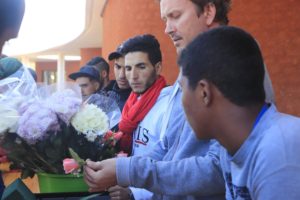 Another milestone was the flower workshop organized by our friends and collaborators Nicolas and Valentin, from Végétal Concept. This interesting workshop on flowers (a field with a great future in Morocco, which we intend to develop) ended up becoming a real spring party!
Another milestone was the flower workshop organized by our friends and collaborators Nicolas and Valentin, from Végétal Concept. This interesting workshop on flowers (a field with a great future in Morocco, which we intend to develop) ended up becoming a real spring party!
External partners
This year, we have the luck of counting with scholarships from the Cervantes Institute, the French Institute, and the French Embassy, which are teaching Spanish and French to our students. Two very useful languages for the labor market.
Another milestone was the flower workshop organized by our friends and collaborators Nicolas and Valentin, from Végétal Concept.
Through its International Relations department, the International University of Rabat is also collaborating with booster sessions on different subjects.
Collaborations are growing, and we have established new relations with the Spanish School and the Liceo Descartes, among others, to promote exchanges and joint activities.
We have also had the privilege of receiving Abdelmounaim Madani, director of ANAPEC (the National agency for the promotion of employment and competencies), an organism with whom we have great perspectives of professional insertion.
There are also gardening services that the School is now able to develop, such as income-generating activities, or professional practices for our students.
 There are also gardening services that the School is now able to develop, such as income-generating activities, or professional practices for our students.
There are also gardening services that the School is now able to develop, such as income-generating activities, or professional practices for our students.
We cannot complain. Things aren’t only running its course, but they are developing and flourishing, as does the fertile landscape of the Bouregreg.
Text and pictures: Inés Eléxpuru – FUNCI


